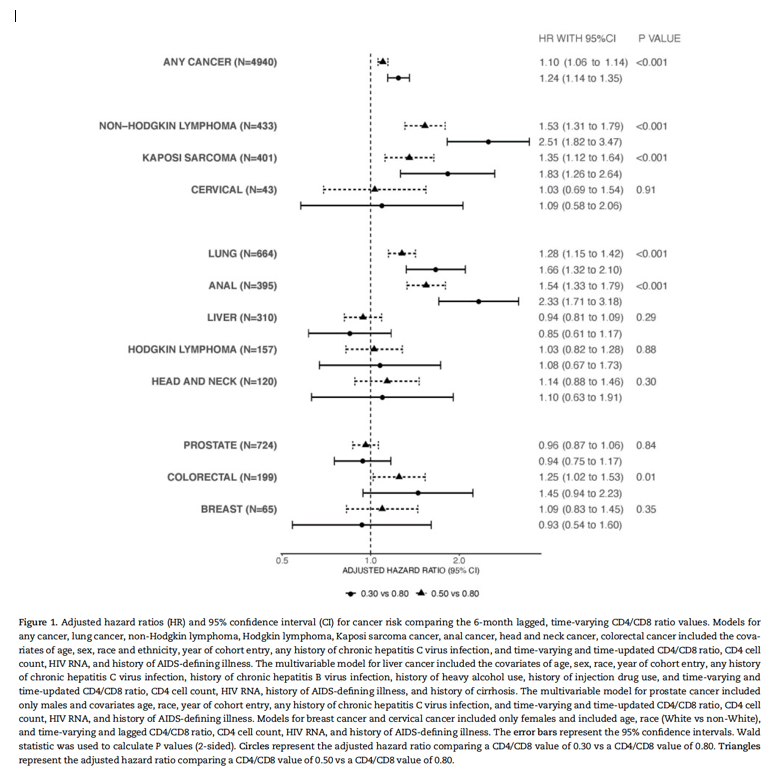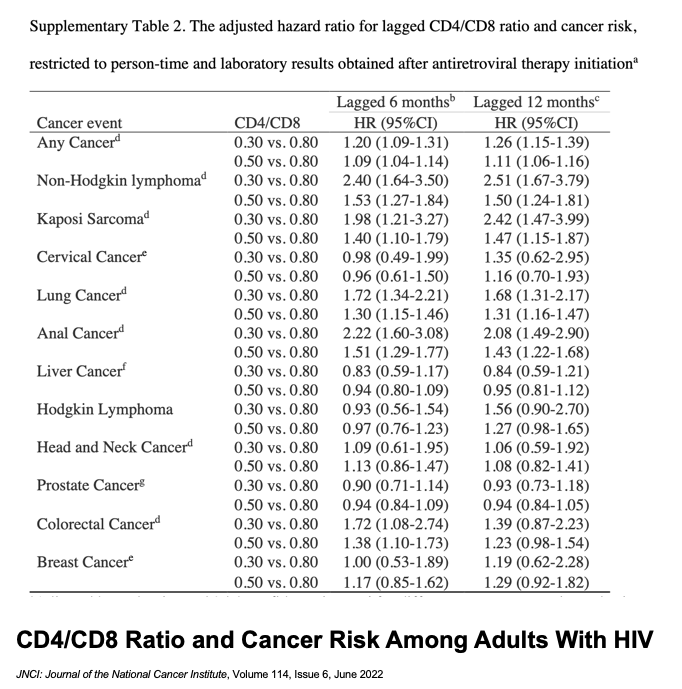| |
CD4/CD8 Ratio & Cancer Risk in PWH
|
| |
| |
Download the PDF here
Download the PDF here
low CD4/CD8 ratio predicted risk of any cancer, independent of age, sex, CD4 cell count, HIV viral load, chronic HCV infection, and smoking history measures. Among PWH, a low CD4/CD8 ratio is associated with older age, low CD4 nadir, male sex, HIV acquisition risk factors (particularly for men who whave sex with men), chronic viral coinfection (including HCV and cytomegalovirus), and large HIV reservoir (27,32-35).
"The twofold increased risk of anal cancer observed between adults with lower compared to higher CD4/CD8 ratio values is particularly striking and may be an important biomarker to inform screening guidelines for this population."
In this large study of PWH in care and with high uptake of ART between 1998 and 2016, we found that a low, time-lagged CD4/CD8 ratio was associated with increased risk of incident cancer diagnoses after accounting for CD4 cell count, HIV viral load, HIV acquisition risk, smoking, and other factors. The inverse association between CD4/CD8 ratio and cancer risk was observed for several specific cancers, including 3 of the most common cancers among PWH in the United States: NHL, lung cancer, and anal cancer. The association between low CD4/CD8 ratio and risk of cancer was not uniform, nor was the association exclusive for cancers associated with oncogenic viruses. Given the robust association up to 24 months before cancer diagnosis, the CD4/CD8 ratio may indicate underlying immune dysfunction affecting carcinogenesis and inform cancer screening and prevention interventions among PWH.
A low CD4/CD8 ratio up to 24 months before cancer diagnosis was independently associated with increased cancer risk in PWH and may serve as a clinical biomarker.
There was a 24% increased risk of any incident cancer for individuals with a 6-month lagged CD4/CD8 ratio of 0.3 compared with 0.8, independent of CD4 cell count, HIV RNA value, and other covariates (adjusted hazard ratio [aHR] = 1.24, 95% CI = 1.14 to 1.35).
We observed the same pattern of increasing cancer risk with decreasing CD4/CD8 ratio for NHL, Kaposi sarcoma, lung cancer, anal cancer, and colorectal cancer. The 6-month-lagged CD4/CD8 ratio was not associated with risk of cervical cancer, Hodgkin lymphoma, head and neck cancer, prostate cancer, breast cancer, or liver cancer.
Approximately 10% of all deaths among PWH prescribed ART in the United States between 1995 and 2009 were attributed to cancer, with NHL, lung, and liver cancer contributing the highest number of deaths (10).
Cancer risk in PWH is attributed to immunodeficiency, immune dysfunction, and high prevalence of oncogenic virus coinfection (including human papillomavirus [HPV] and hepatitis C virus [HCV]) and behavioral risk factors, including smoking (12-15).
A low CD4/CD8 ratio is also associated with older age, cytomegalovirus coinfection, and low CD4 cell count nadir, and has been associated with risk of non-AIDS outcomes (18,21-27).
Compared with a 6-month lagged CD4/CD8 of 0.80, a CD4/CD8 of 0.30 was associated with increased risk of any incident cancer (adjusted hazard ratio = 1.24 [95% confidence interval = 1.14 to 1.35]). The CD4/CD8 ratio was also inversely associated with non-Hodgkin lymphoma, Kaposi sarcoma, lung cancer, anal cancer, and colorectal cancer in adjusted analyses (all 2-sided P < .05).
Figure 1 shows the adjusted hazard ratios and 95% confidence intervals (CIs) comparing the 0.3 and 0.5 with the 0.8 CD4/CD8 ratio values of our primary analysis. There was a 24% increased risk of any incident cancer for individuals with a 6-month lagged CD4/CD8 ratio of 0.3 compared with 0.8, independent of CD4 cell count, HIV RNA value, and other covariates (adjusted hazard ratio [aHR] = 1.24, 95% CI = 1.14 to 1.35). We observed the same pattern of increasing cancer risk with decreasing CD4/CD8 ratio for NHL, Kaposi sarcoma, lung cancer, anal cancer, and colorectal cancer. The 6-month-lagged CD4/CD8 ratio was not associated with risk of cervical cancer, Hodgkin lymphoma, head and neck cancer, prostate cancer, breast cancer, or liver cancer. We similarly observed an inverse association of CD4/CD8 ratio and risk of any cancer for all race and ethnicity groups, though the magnitude of the CD4/CD8 ratio effect on outcome varied by race (interaction term overall P value <.001) (Supplementary Figure 3, available online).

The multivariable analyses including the subset of patients with available smoking, alcohol, HIV acquisition risk factor, and body mass index data that assessed 6-month lagged CD4/CD8 ratio and cancer risk are shown in Figure 3. Given the smaller number of cancers included in the sensitivity analyses, only any cancer, NHL, Kaposi sarcoma, lung cancer, and anal cancer were assessed in multivariable models to avoid overfitting. The inverse association between low CD4/CD8 ratio and increased cancer risk persisted for any cancer, NHL, lung cancer, and anal cancer but was attenuated and no longer statistically significant for Kaposi sarcoma.

Abstract
Background
Independent of CD4 cell count, a low CD4/CD8 ratio in people with HIV (PWH) is associated with deleterious immune senescence, activation, and inflammation, which may contribute to carcinogenesis and excess cancer risk. We examined whether low CD4/CD8 ratios predicted cancer among PWH in the United States and Canada.
Methods
We examined all cancer-free PWH with 1 or more CD4/CD8 values from North American AIDS Cohort Collaboration on Research and Design observational cohorts with validated cancer diagnoses between 1998 and 2016. We evaluated the association between time-lagged CD4/CD8 ratio and risk of specific cancers in multivariable, time-updated Cox proportional hazard models using restricted cubic spines. Models were adjusted for age, sex, race and ethnicity, hepatitis C virus, and time-updated CD4 cell count, HIV RNA, and history of AIDS-defining illness.
Results
Among 83 893 PWH, there were 5628 incident cancers, including lung cancer (n = 755), Kaposi sarcoma (n = 501), non-Hodgkin lymphoma (n = 497), and anal cancer (n = 439). The median age at cohort entry was 43 years. The overall median 6-month lagged CD4/CD8 ratio was 0.52 (interquartile range = 0.30-0.82). Compared with a 6-month lagged CD4/CD8 of 0.80, a CD4/CD8 of 0.30 was associated with increased risk of any incident cancer (adjusted hazard ratio = 1.24 [95% confidence interval = 1.14 to 1.35]). The CD4/CD8 ratio was also inversely associated with non-Hodgkin lymphoma, Kaposi sarcoma, lung cancer, anal cancer, and colorectal cancer in adjusted analyses (all 2-sided P < .05). Results were similar using 12-, 18-, and 24-month lagged CD4/CD8 values.
Conclusions
A low CD4/CD8 ratio up to 24 months before cancer diagnosis was independently associated with increased cancer risk in PWH and may serve as a clinical biomarker.
|
|
| |
| |
|
|
|